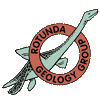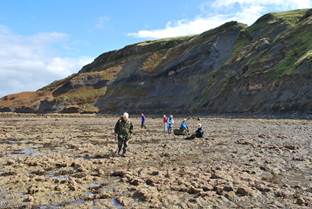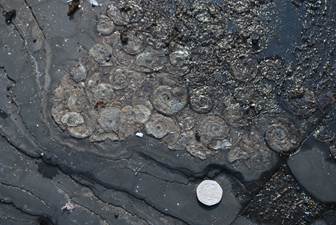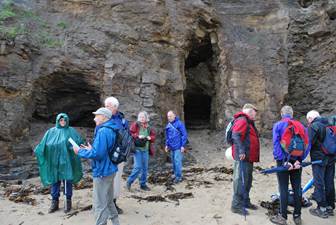The east cliffs and shore of Runswick Bay exhibit the following geological succession.
| Formation | Member | Ammonite Zone |
| Mulgrave Shale | Harpoceras falcifer | |
| Whitby Mudstone | ||
| Grey Shale | Dactylioceras tenuicostatum | |
| Cleveland Ironstone | Kettleness | Pleuroceras spinatum |
The wave cut platform of the middle shore is formed of a hard red ironstone seam that forms the top of the Cleveland Ironstone Formation. The Grey Shale Member consists of grey, flaky micaceous shales with bands of nodules. In the lower beds the nodules frequently contain well-preserved specimens of Dactylioceras tenuicostatum, whilst the higher horizons yield Dactylioceras semicelatum. Few other fossils are generally found in the Grey Shale deposits. A bed containing ‘cannon-ball’ doggers with a splintery skin of iron pyrite forms the lowest bed of the Mulgrave Shale Member and marks the base of the Harpoceras falciferum Zone.
Within this succession of sediments there are profound changes of lithology and bio-stratigraphy that indicate major changes in sea level and marine paleoecology. The aim of the visit to Runswick Bay and Kettleness was to first identify, and then try to explain the changes presented in the deposition of the sediments.
Two questions were presented to the group.
- Was there a major break in deposition between the top of the Kettleness Member and the base of the Grey Shale Member that would account for the apparent extinction of the Pleuroceratid ammonites and the rise of the Dactylioceratids as well as the change from fossil rich ironstone deposits to poorly fossiliferous laminated micaceous shales?
- Why did the sparsely nodular Grey Shales give way to the pyrite rich highly organic black shales with abundant pyrite coated hard splintery nodules in the Mulgrave Shale Member with again major changes in ammonite species?
At Hob Holes the cliffs are formed of the Jet Rock within the Mulgrave Shale Member The excavations known as Hob Holes were formed by jet workers cutting into the shale to extract good quality jet preserved as a form of fossil wood with a cell structure similar to that of the modern monkey puzzle tree, Araucaria araucana.
Large lenticular doggers mark the top of the Jet Rock. The dark, almost black shales, were seen to be finely laminated indicating deposition in low energy conditions with gentle currents giving rise to small scale cross and current bedding. The pyriteous shale smelt strongly of crude oil when struck with a hammer, promoting discussion on its suitability as an oil shale and the future possibility of economic oil extraction from the Mulgrave Shale Member within Yorkshire.
Peter Rawson then explained to the group that the shales with their high organic content have been recognised as indicating ocean-wide anoxia at the sediment-water interface. This extended throughout most of the Toarcian and became known as the Toarcian Oceanic Anoxic Event (TOAE). The cause of this event, which characterised the Exaratum sub-zone in North West Europe is controversial.
From Hob Holes the party moved across the beach to the wave cut platform formed of beds of the underlying Grey Shale Member. Crushed specimens of the zone ammonite, Dactylioceras tenuicostatum, were found in some numbers along with several belemnites tentatively identified as Acrocoelites sp. many specimens of which were worn by erosion to clearly show the guard and phragmacone in section preserved in green calcite. It was explained that rapid subsidence within the Cleveland Basin caused the deposition of the relatively deep open water silty micaceous sediments of the Grey Shale Member with evidence of cyclic fluctuations of oxic and anoxic conditions in the bottom environment during sedimentation.
Proceeding along the shore towards Hill Stones, the small headland separating Runswick Bay from Kettleness Sands, we worked down sequence. The junction between the Grey Shale Member and the Kettleness Member was difficult to determine but is generally recognised by a double row of ironstone cannon ball doggers.
Packed lunch was taken in warm sunshine on the wave-cut platform where several of the larger ironstone concretions in the Kettleness Member provided dry seats. The outcrop of the Kettleness Member on the wave cut platform is part of a condensed sequence of ironstones interspersed with silty to sandy mudstones. Fossils recognised included Pleuromya costata and Pleuroceras (Paltopleuroceras) sp, with Pseudopecten equivalvis being the most common fossil. Deposition was explained as being laid down in a shallowing phase due to regional tectonic uplift within the Cleveland Basin giving rise to a normal marine shelf environment subject to storm surges with iron leaching from lateritic soils in a low-lying well vegetated sub-tropical landmass.
After lunch the group proceeded round the small land-slipped headland of Hill Stones onto the wave cut platform of Kettleness Sands which is formed of a most excellent exposure of the Mulgrave Shale Member characterised by numerous pyrite coated nodules in the typical highly organic black shales. Fine examples of tetrahedral crystals of pyrite formed within the shales were collected by some of the group. The locality is also well known as a prime area for jet by local people. A rather poorly preserved crushed section of fossil wood was found that enabled members to collect small samples of good jet from it.
Many fossils may be found in the Mulgrave Shale Member, most of them crushed and presenting as pyrite coated films in the shales but some enclosed in the hard splintery nodules. The ammonites Harpoceras sp, Ovaticeras sp and Phylloceras heterophyllum are frequently found and the bivalve Pseudomytiloides dubium is abundant in some horizons. This led to much discussion as the abundance of a rich fossil assemblage may well appear to contradict the anoxic conditions unless an assemblage such as that of Pseudomytiloides dubium is a death assemblage or, what was felt to be more likely, a rich fauna that occupied the water column well above the anoxic sediment water interface and was subject to good conditions of preservation within the deoxygenated sea-bed sediments. One member pointed out that some modern bivalves have adapted to conditions very hostile to most life, such as underwater volcanic plumes, and suggested that Pseudomytiloides dubium may have actually adapted to the anoxic sea bed conditions.
From Hill Stones the type locality of the Kettleness Member is tantalisingly close but with a spring tide flowing it was deemed wise not to proceed further along the beach and the party returned round Hill Stones back to Runswick Bay.



